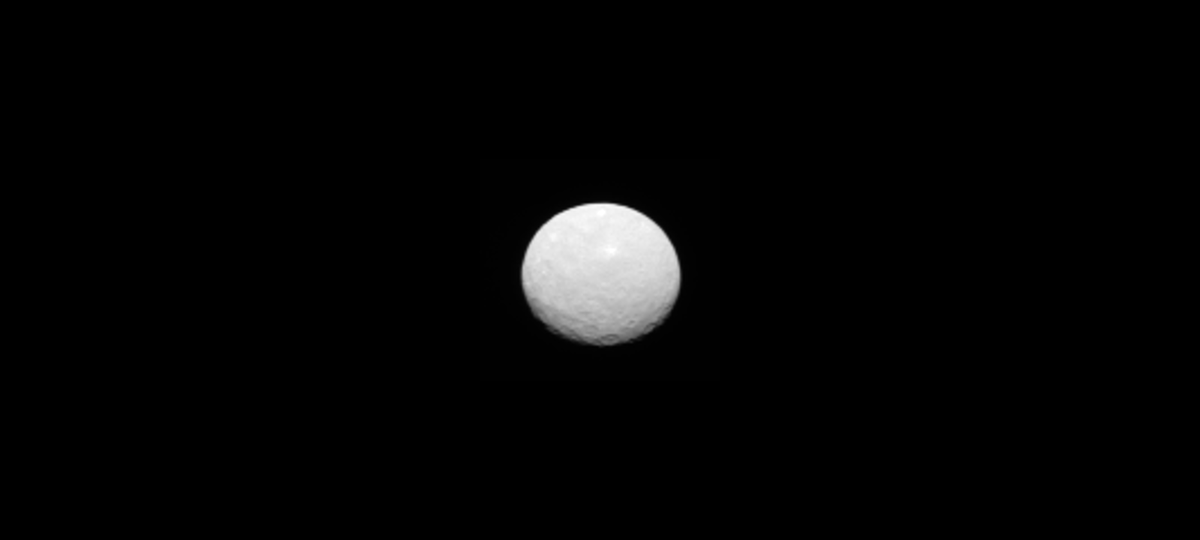

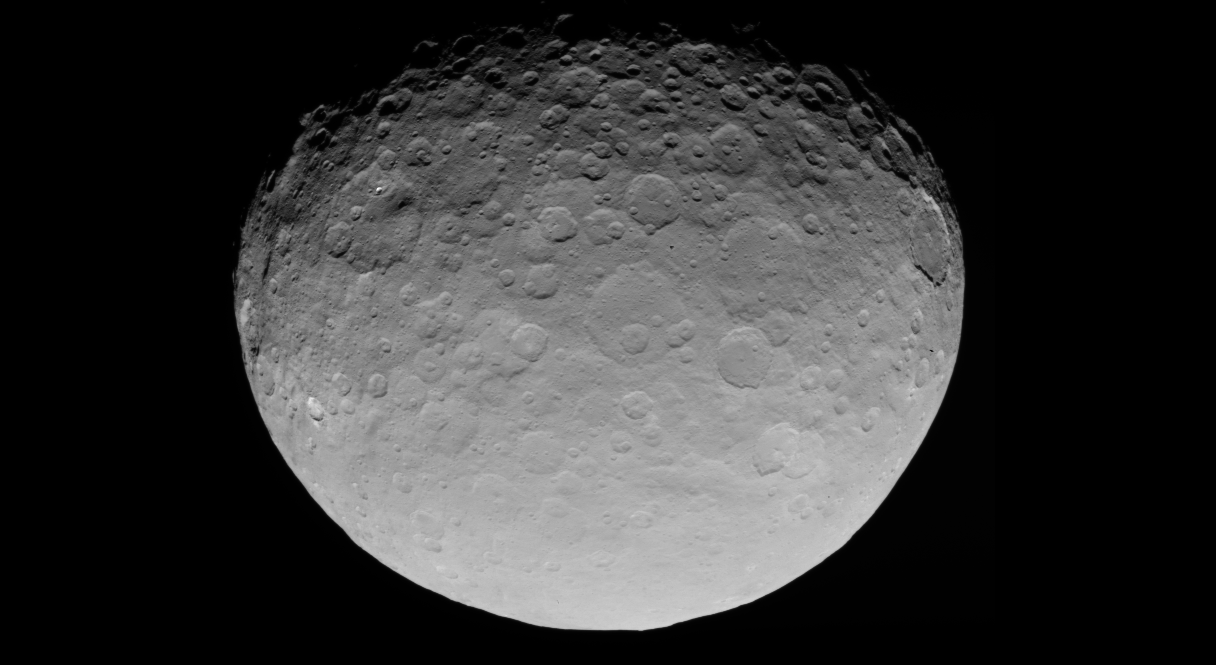
New Horizons arrived at Pluto and its satellites June 2015. Since it was launched more satellites have been discovered around Pluto. See below for more details and latest pictures.
In 1772, Johann Bode, Director of Berlin Observatory, republished this theory without credit or reference to Titius, and also proposed a missing planet between Mars and Jupiter at 28 Bode Units. Since Bode plagarized and popularised the idea, it is known as Bode's Law.
The Earth to Sun distance is one astronomical unit, and ten Bode's Law units, so there are ten Bode's Law units in one astronomical unit. When Uranus was discovered in 1781, it was found to orbit the Sun at 192 Bode's Law units. The calculation according to Bode's Law would have been 196, so near, it was thought to verify the law. But when Neptune was discovered beyond Uranus in 1846, it did not fit Bode's Law, at 30.1 AU.
In 1785, a Hungarian Baron, Franz Xavier von Zach, began to search for the 'missing planet' which according to Bode must lay between Mars and Jupiter at 28 Bode units. Having no success, in 1800 he set up a group of astronomers called the Celestial Police, to find the missing planet. They divided the Zodiac into zones and allocated different areas to different astronomers in the group.
 On the 1st January 1801, an astronomer who was not a member of the Celestial Police, Giuseppi Piazzi, who was compiling a star catalogue at Palermo Observatory in Sicily, discovered Ceres.
On the 1st January 1801, an astronomer who was not a member of the Celestial Police, Giuseppi Piazzi, who was compiling a star catalogue at Palermo Observatory in Sicily, discovered Ceres.The orbit of Ceres was calculated by the mathematician Gauss as 27.7 Bode units which fitted the sequence. But Ceres was too small to be classified as a missing planet, its diameter is about 924 km. The search was on for another planet.
In August 2006, Ceres was re-classified as a dwarf planet - along with Pluto, Ceres and 2003 UB313, under the new definitions of planets in and other bodies in the solar system. These are bodies directly in orbit around the Sun and not moons orbiting another planet, which are large enough to be round.
Update on Ceres the small, round, dwarf planet. Ceres was visited by NASA's Dawn mission, in March 2015.
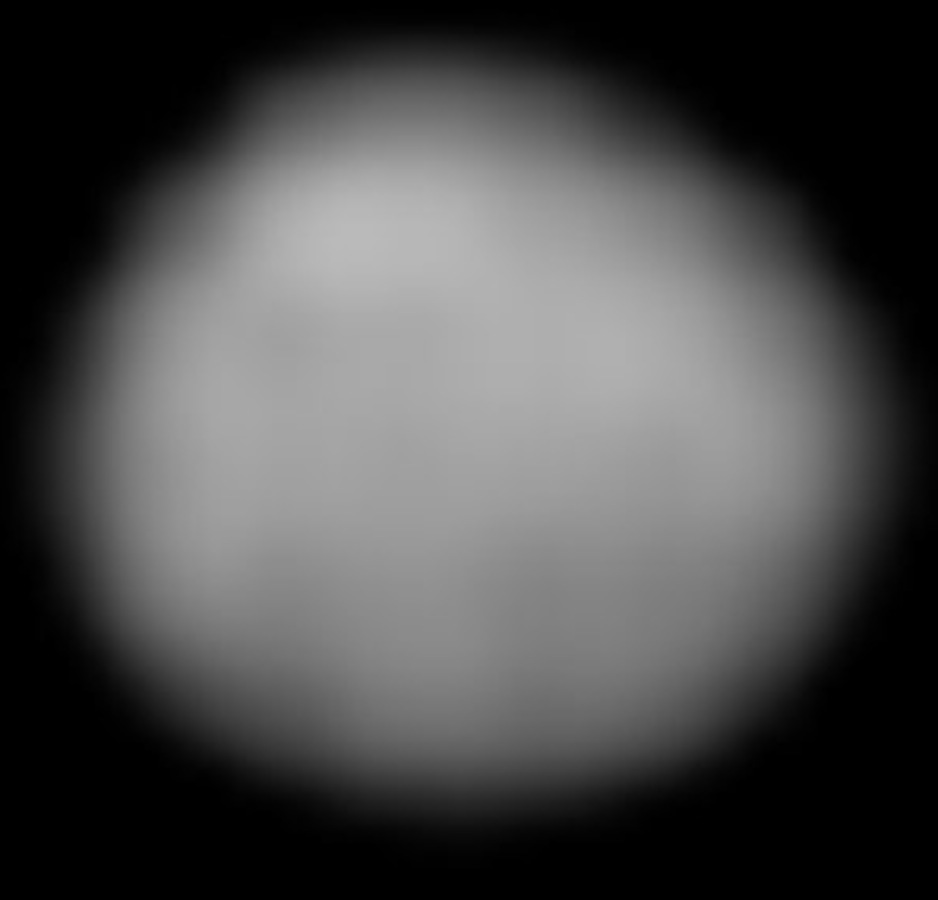
Pallas was identified as a protoplanet in October 2009, after high-resolution images from Hubble, showed it to be rounded, with features. Not just a lump of rock.
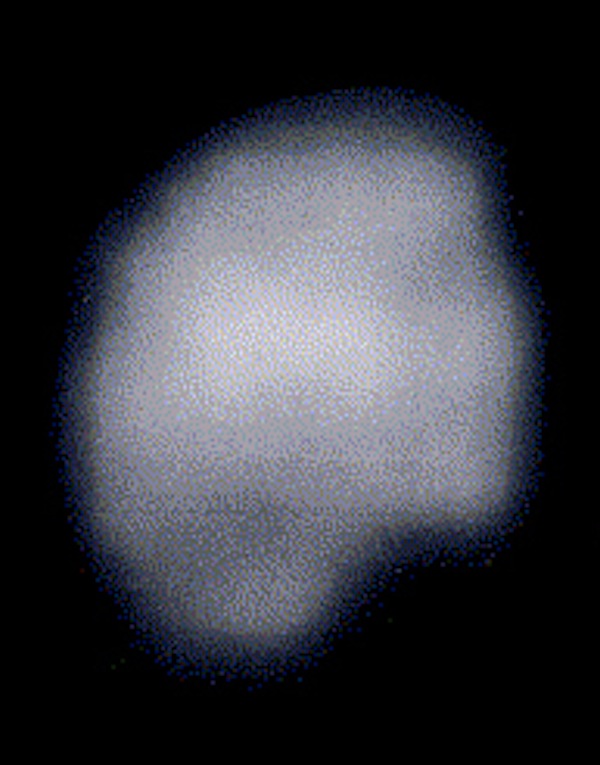
The Celestial Police were disbanded in 1815, but since then thousands of asteroids have been numbered, and named, and data collected on them. Many thousands were found by the infra-red telescope on the IRAS satellite, in 1983 to add to the 4,000 or so, then known, and since then many more new discoveries are made each year.
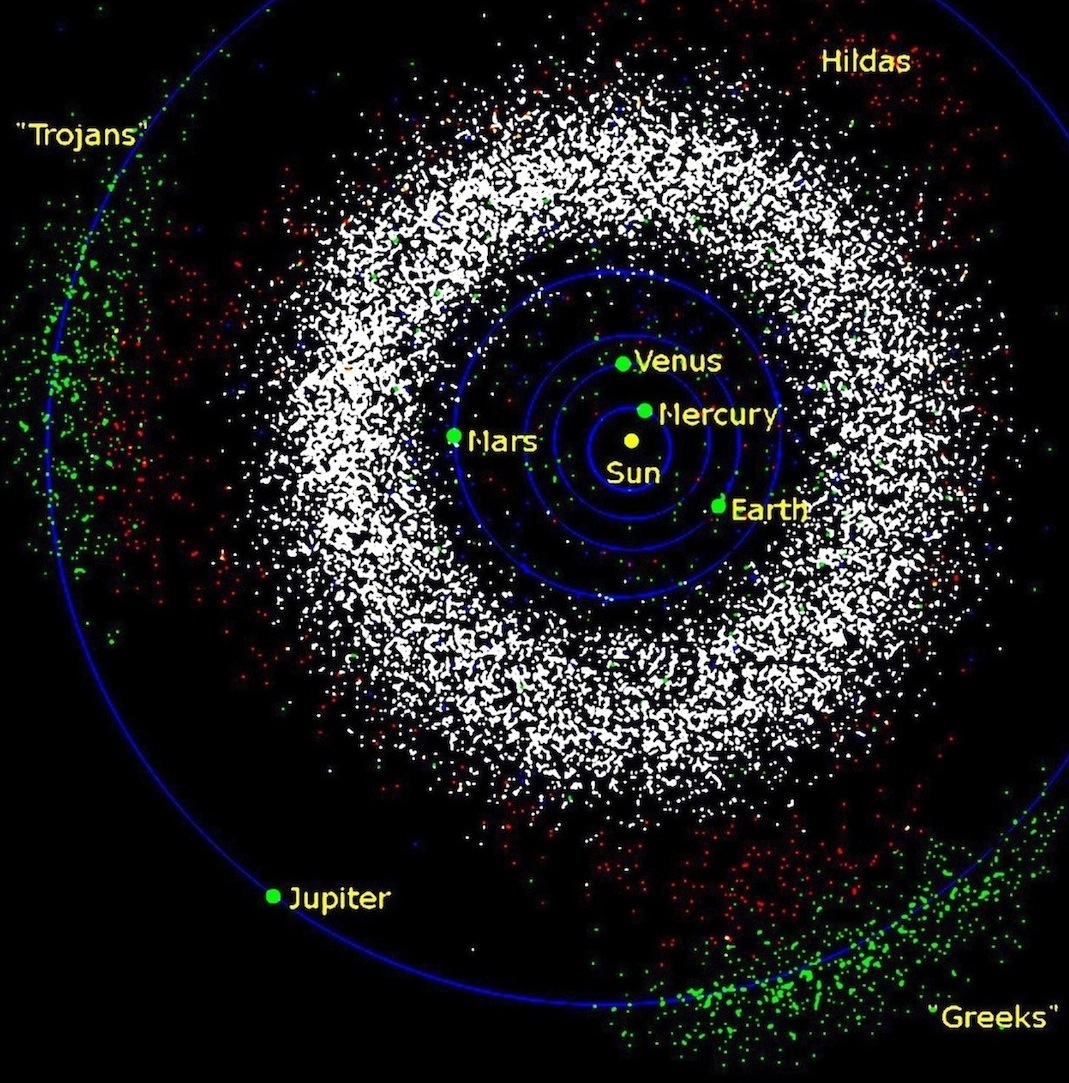
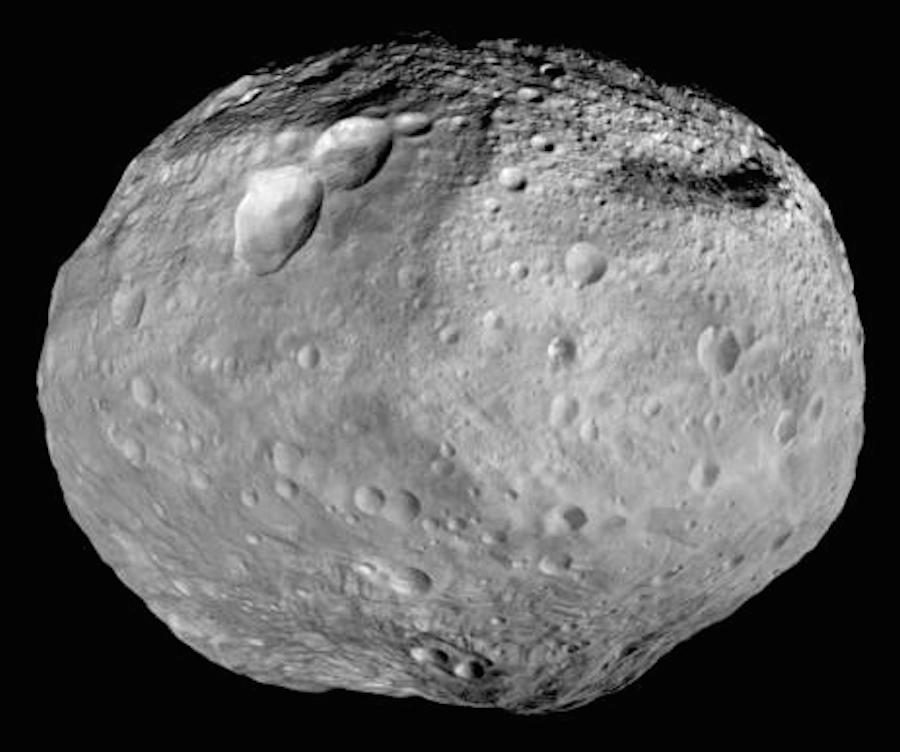
was discovered in March 1807 by Heinrich Olbers. In 1994 the Hubble Space Telescope looked at Vesta during its complete rotation - 5.3 hours. Vesta has a diameter of 525 km. and is 252 million km. from Earth. Spectroscopy has shown the surface of Vesta to be covered with large regions rich in basalt, so lava must have once flowed on the surface. This means Vesta has a hot core. Possibly this contains radioactive material present when Vesta formed. This would be material left over from a supernova which had exploded in the region of the Milky Way were the Sun and its planets were forming. Energy from this radioactive isotope melted Vesta's core, making it a differentiated body like the Earth. Although very small, it could be the 6th Earth-like planet.
Soon after its formation, more than 4,000 million years ago, molten lava welled to the surface and then cooled down. Not a lot has happened since then on Vesta which has one of the oldest surfaces in the Solar System. The only exception is where bits have been broken off Vesta in impacts and collisions with smaller asteroids. A large impact basin can be seen. The deeper layers of olivine have been revealed where the crust is broken off. Bits of this crust have landed as meteorites on Earth. They are identified by the spectral signature of pyroxene which is found in lava. One bit landed in Australia in 1960, the meteorite of Millbillillie which is almost all pyroxene.
Vesta is now identified as a proto-planet, not just a lump of rock.
NASA's Dawn probe entered orbit around Vesta on July 15, 2011. After that, the next stop was the dwarf planet Ceres. More information on Nasa website.
Animation of Vesta's rotation, showing its surface.
5th September 2012 Dawn left Vesta and headed for Ceres.
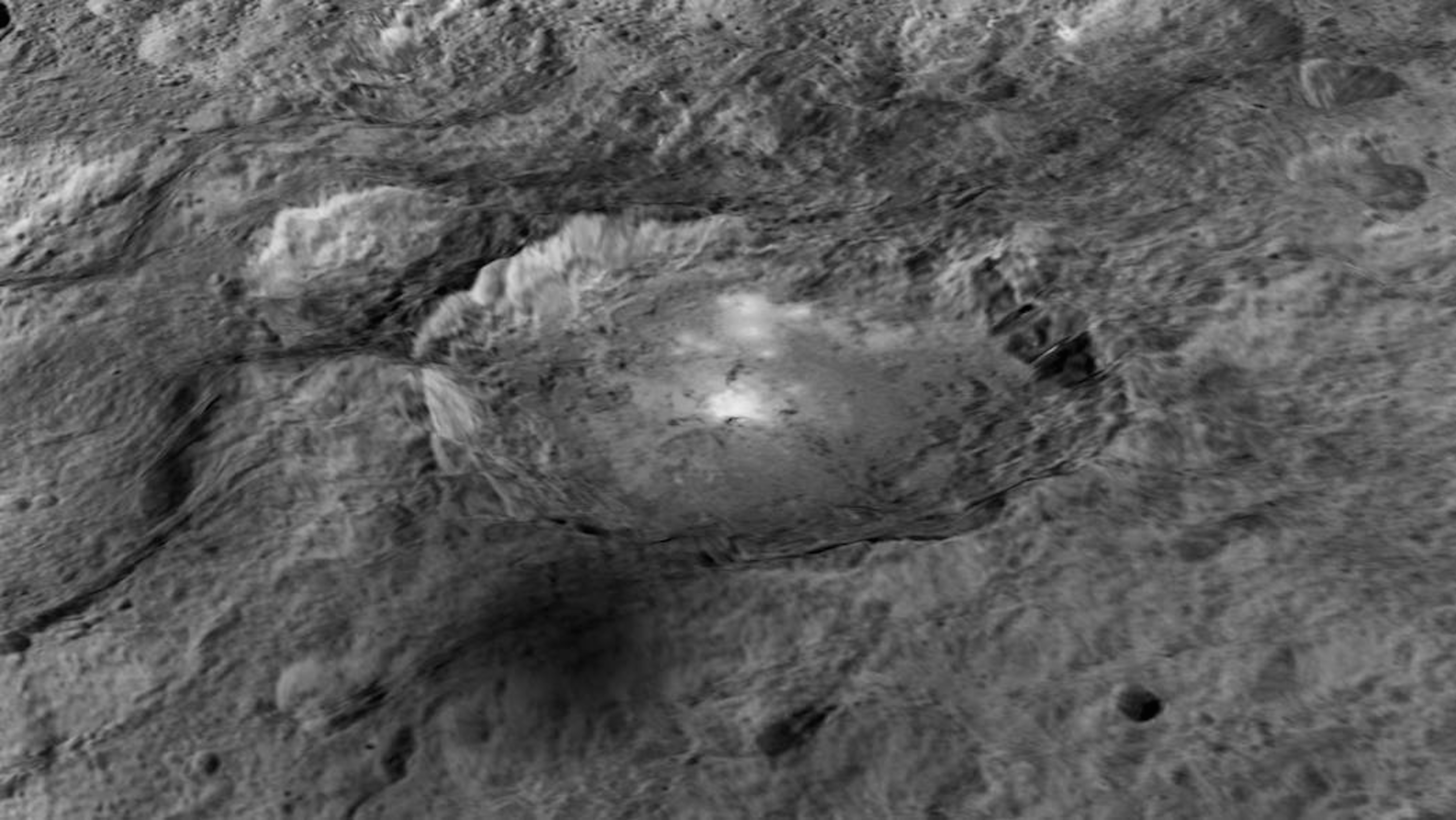
The bright spot seen on this photo taken on the Dawn survey, is in a crater now named Occator, which is about 4 km deep.
Orbits and resonance
In 1867, the American astronomer Daniel Kirkwood noticed that there were gaps in the orbits of asteroids between Mars and Jupiter. The gaps and clusters of asteroids correspond to resonances with Jupiter. For example, there is a clump of asteroids, the Hildas, at the 3:2 resonance, but at the 2:1 resonance where the bodies would complete two revolutions for one of Jupiter's orbits, there is a gap. At the 3:1 resonance, 2.5 AUs from the Sun, there is another gap with only very few asteroids, Alinda and Quetzalcoatl are two of them. There are also gaps at resonances 4:1, 5:2 and 7:2. Computing the 3:1 resonance band over a time-scale of millions of years showed that this is a chaotic zone where bodies are thrown into increasingly eccentric and therefore more elliptical Mars-crossing orbits. They are then affected by Mars and thrown out into totally different orbits. Asteroids thrown out of the 3:1 resonance can be on a collision course with Earth. This has happened in the past and has caused devastation and mass extinction of life.
As there are still some asteroids left in this resonance band it might easily happen again, especially as there are already many bodies narrowly missing the Earth each year, and many more small rocks are constantly bombarding the Earth. (see below for more on threatening asteroids).
At the 3:2 resonance where the Hildas clump there is no chaotic zone.
Other groups of asteroids include the Hungarias at near 2 AU, the Floras and Phoceas, before the 3:1 gap, then there are more clusters, with gaps at 5:2 and 7:3 resonances, then the Eos, the Themis, the 2:1 gap, the Cybeles, then very few until the Hildas, then the small Thule clump at 4:3, then there is the Trojans at 1:1, in Jupiter's orbit.
Computers have made it possible to plot out the orbits of the asteroids.
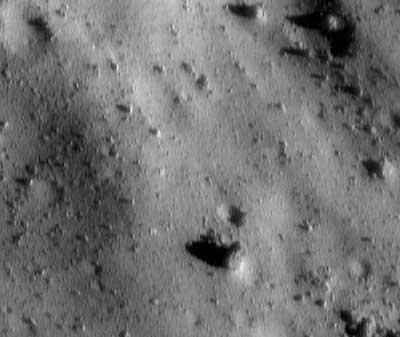 Information on the shape and composition of asteroids has been obtained from their reflected sunlight. For example, short-term regular variations indicate an irregular shape about the spin axis. Radar has been used to obtain information on the asteroid's distance, size, spin rate, orientation and surface properties, by measuring the timing of the echoes.
Information on the shape and composition of asteroids has been obtained from their reflected sunlight. For example, short-term regular variations indicate an irregular shape about the spin axis. Radar has been used to obtain information on the asteroid's distance, size, spin rate, orientation and surface properties, by measuring the timing of the echoes.
Spectroscopic measurements of the reflected light give information on the chemistry of the body. Most of the asteroids are composed of dark carbon material, others are rich in iron and in magnesium silicates. A few vary widely, e.g. Vesta is mainly grey basalt, Psyche, metal, and Dembowska, olivine. Asteroids have been classified since the 1970s. Since 1984 the classes are designated by the letters S,C,M,D,F,P,G,E,B,T,A,V,Q,R, according to their composition. There are three main superclasses:
 At the end of October 1991, the Galileo probe bypassed the asteroid 951Gaspra and transmitted a photo of this 12 km. wide potato shaped body
At the end of October 1991, the Galileo probe bypassed the asteroid 951Gaspra and transmitted a photo of this 12 km. wide potato shaped body
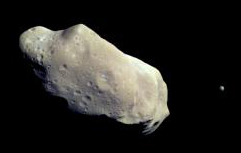 and in August 1993, the asteroid 243 Ida with its own little moon, Dactyl. More than a dozen craters larger than 80 m. in diameter could be seen on this little moon.
and in August 1993, the asteroid 243 Ida with its own little moon, Dactyl. More than a dozen craters larger than 80 m. in diameter could be seen on this little moon.
Unlike Vesta, Gaspra and Ida had once been part of larger bodies which had broken up.
Names were asked for Ida's little moon. Cataloguing the asteroids is done jointly by the Minor Planet Center in Cambridge, Mass. USA under Brian Marsden, who publish 'Minor Planet Circulars' and the Institute for Theoretical Astronomy in St.Petersburg, Russia who publish Ephemerides of Minor Planets.
When an asteroid is discovered it is given a temporary number, the year of discovery, followed by two letters. The first letter indicates the half-month the discovery was made (I and Z are not used). The second shows the order of discovery within that half-month. If there are so many the letters are used up a subscript number is added, e.g. 1992HZ would be followed by 1992HA1 if they were found in the same two weeks. Karla is 1993 FW.
After the orbit has been determined the object is given a permanent number and can be named by its discoverer. Although some have stuck to classical names, these are running out, and others have been more adventurous. Asteroids are named after places such as Evenkia, Buryatia. Famous people, especially those who might help research funding. Characters from books and films. They have been named after wives or husbands, mothers, daughters, and pet cats. One had been named after Colin Pillinger who made valiant efforts to get Britain's Mars probe Beagle 2 on to Mars - which because it did not get adequate government and industry support was not engineered enough with enough fail safe backups to ensure a safe landing.
By the end of the 19th century, asteroids were discovered with orbits which were not between Mars and Jupiter. In 1898, Dr. G. Witt of Berlin discovered Eros, which crossed the orbit of Mars. In 1906, Achilles was discovered by Max Wolf in the same orbit as Jupiter, 60 degrees ahead. Other asteroids were found around here and also 60 degrees behind. These were named after the heroes of the Trojan war and were called 'Trojans'. They are stabilised at the Lagrangian points of Jupiter's orbit.
(In 1772, French mathematician Comte Jean Louis Lagrange found that a small object could travel in the same orbit as a larger one, i.e. a planet, if it formed an equilateral triangle between the planet and the sun.)
Those ahead of Jupiter are named after heroes on the Greek side, and those following after are on the Trojan side. There is a large number of these dark little planets in 1:1 resonance with Jupiter.
Near Earth Asteroids (NERs) - the dangerous ones
Many asteroids are found much nearer the Sun. In 1931, Karl Reinmuth in Heidelberg found Apollo which crosses the Earth's orbit - it came within 1 million km. of the Earth in 1931. In 1932, E. Delporte in Belgium found Amor, which crosses the orbit of Mars and reaches the Earth's orbit Adonis was found in 1936 by Delporte about 2 million km. from the Earth, and Reinmuth found Hermes in 1937 when it was 800,000 km. from the Earth.
In 1976, Eleanor Helin found Aten which orbits inside the Earth's orbit. Discovered early in 1991, the object 1991DA, has an orbit that carries it from near Mars, at 1.4 AUs to beyond Uranus at 19 AUs. In March 1989, an asteroid passed about 500,000 km from the Earth.
Asteroids which may cross the Earth's orbit,(and therefore might at some time impact the Earth, with devastating consequences if they are large bodies), are classified into four groups. Asteroids with orbits which come closer to the sun than the Earth, are called Atens, and are given ancient Egyptian names.
The Amors come around the orbit of Mars. The Apollos approach Earth's orbit.
The Arjuna family are Apollos which are in orbits similar to Earth's. These most often pass close to the Earth and are the ones most likely to collide with the earth at some time. On the positive side, these asteroids would be easy to reach from Earth and exploit for mineral resources. Easier than the Moon, since while the escape velocity of the Moon is 2,400 metres per second, that of a 100 metre in diameter Arjuna is less than 0.2 metres per second, so large loads of material could be lifted off.
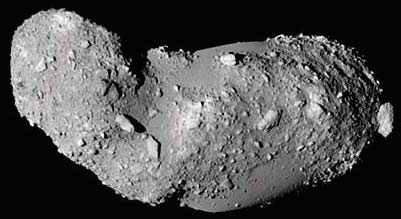 |
An Apollo asteroid which crosses the orbit of Mars and comes near the Earth. It was discovered on September 26th 1998 and named after Hideo Itokawa (1912-1999) the Japanese rocket scientist.
It is an S-type (stoney) asteroid. The Japanese probe Hayabusa arrived 20 km away from Itokawa on 12th September 2005, and analysed it. But it had steering problems. The small probe Minerva released by Hayabusa, drifted off into space instead of landing on the surface. Hayabusa did eventually manage to land safely home. The micrograins returned by the Hayabusa apacecraft collected from the surface of the asteroid 25143 - Itokawa have now been analysed. They reveal that impacts have played a role in shaping not only the exteriors of large planetary bodies, but also the smaller bodies such as asteroids. |
This makes it important to detect any large bodies heading for impact with Earth. During the 1980s near Earth asteroids were looked for by using photographic plates taken with a small telescope. The photographs were taken of the darkest part of the sky at the darkest time of the month. The observer photographed a small portion of the sky, then covered the same part again, later. Then the photographic plates were developed to check any bodies which had changed position. One objects more than 250 m. in diameter could be detected this way.
Since 1990, CCD cameras have been used and the image processed by computer. The area of sky is scoured twice, any changed features are tagged by the computer, then a third image eliminates odd marks and glitches, leaving the likeliest objects to be detected by the computer operator and sent to Brian Marsden's data base for numbering. Many objects some only a few meters across have been found this way near the Earth. This was how the Arjuna family of asteroids were found.
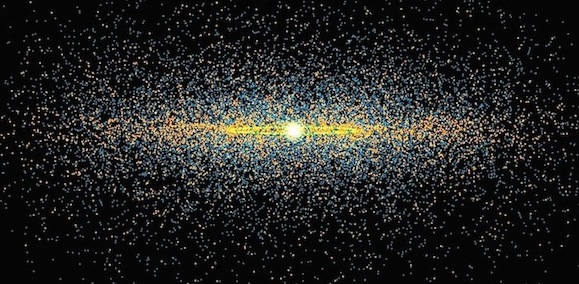
Pictures shows that out of the usual NEAs (near Earth asteroids) the more potentially hazardous asteroids (PHAs) or more likely to orbit near the plane of our solar system. PHAs are defined as being large enough to survive the passage through the Earth's atmosphere and cause a large amount of damage.
25th February, 2013: Indian rocket launches satellites including a Canadian orbiter to scan for threatening asteroids.
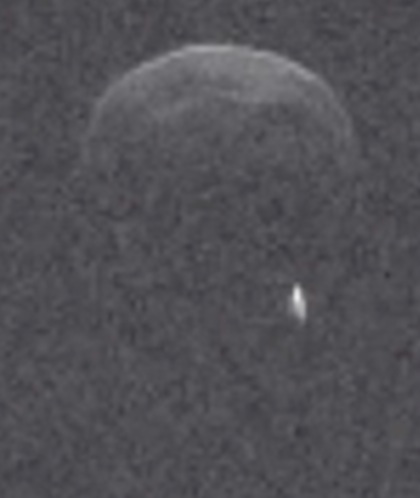 May 31, 2013, in the evening (GMT) Asteroid 1998 QE2 missed us by 3.6 million miles. It is 1.7 miles wide and has its own moon. If it hit us it would have been catastrophic however it didn't.
May 31, 2013, in the evening (GMT) Asteroid 1998 QE2 missed us by 3.6 million miles. It is 1.7 miles wide and has its own moon. If it hit us it would have been catastrophic however it didn't.The Chelyabinsk meterorite's orbit has now been traced to its origin in the asteroid belt between Mars and Jupiter. It looks like it could have been knocked off course by a collision.
February, 2013. Just before Asteroid 2012 DA14 swooped past and off again, a big meteor landed in Chelyabinsk on 15th February 2013. Causing damage and about 500 people were injured by flying glass from broken windows etc. Chelyabinsk was already famous for the 1957 nuclear disaster.

These are asteroids in orbits between Jupiter and Neptune. The bodies further out from the Sun than Jupiter, are usually cold enough to retain ice frozen enough to become part of the rock of the planet.(Ice has five more phase changes from the ice we are familiar with on Earth, and becomes more like a rock.
In 1920, Hidalgo was discovered by Walter Baade. It has an orbit which crosses that of Jupiter out beyond the orbit of Saturn. In 1977, 2060 Chiron was found by Charles Kowal, which travels between the orbits of Saturn and Uranus, and is about 200 km. in diameter. As it passed by Saturn on its perihelion, it gave off a dusty coma due to increased heat and the tidal effects upon it from Saturn. This gave rise to doubts that it was an asteroid, perhaps it was a comet. It was just the heat. Comets are icy bodies thrown into extremely elliptical orbits that bring them near the Sun, causing outgassing from their rocks. The orbit of Chiron is chaotic. Computer simulations show that Chiron's orbit may cross that of the Earth every 100,000 years.
In January 1992, Pholus (1992AD) was discovered orbiting between Saturn and Neptune. It also has a diameter of 200 km. In 1993 HA2 was discovered which is 80 km. in diameter. Many more asteroids are being discovered in this region.

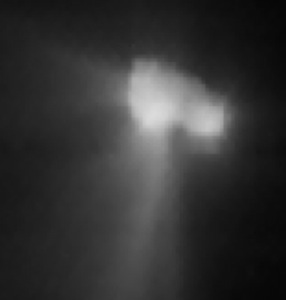 That comets return periodically and have orbits was first noticed by Edmund Halley with the comet named after him. Halley's comet could be traced in astronomer's records back nearly 4,000 years. In 1985-6 technology had reached the stage when it was possible to send probes out to the comet and find out more. The European probe Giotto flew closest and took the most fascinating photos - the first time a comet had been seen close to - although its appearance from Earth was disappointing - it could only been seen with a telescope - as a little fuzzy cloud.
That comets return periodically and have orbits was first noticed by Edmund Halley with the comet named after him. Halley's comet could be traced in astronomer's records back nearly 4,000 years. In 1985-6 technology had reached the stage when it was possible to send probes out to the comet and find out more. The European probe Giotto flew closest and took the most fascinating photos - the first time a comet had been seen close to - although its appearance from Earth was disappointing - it could only been seen with a telescope - as a little fuzzy cloud.
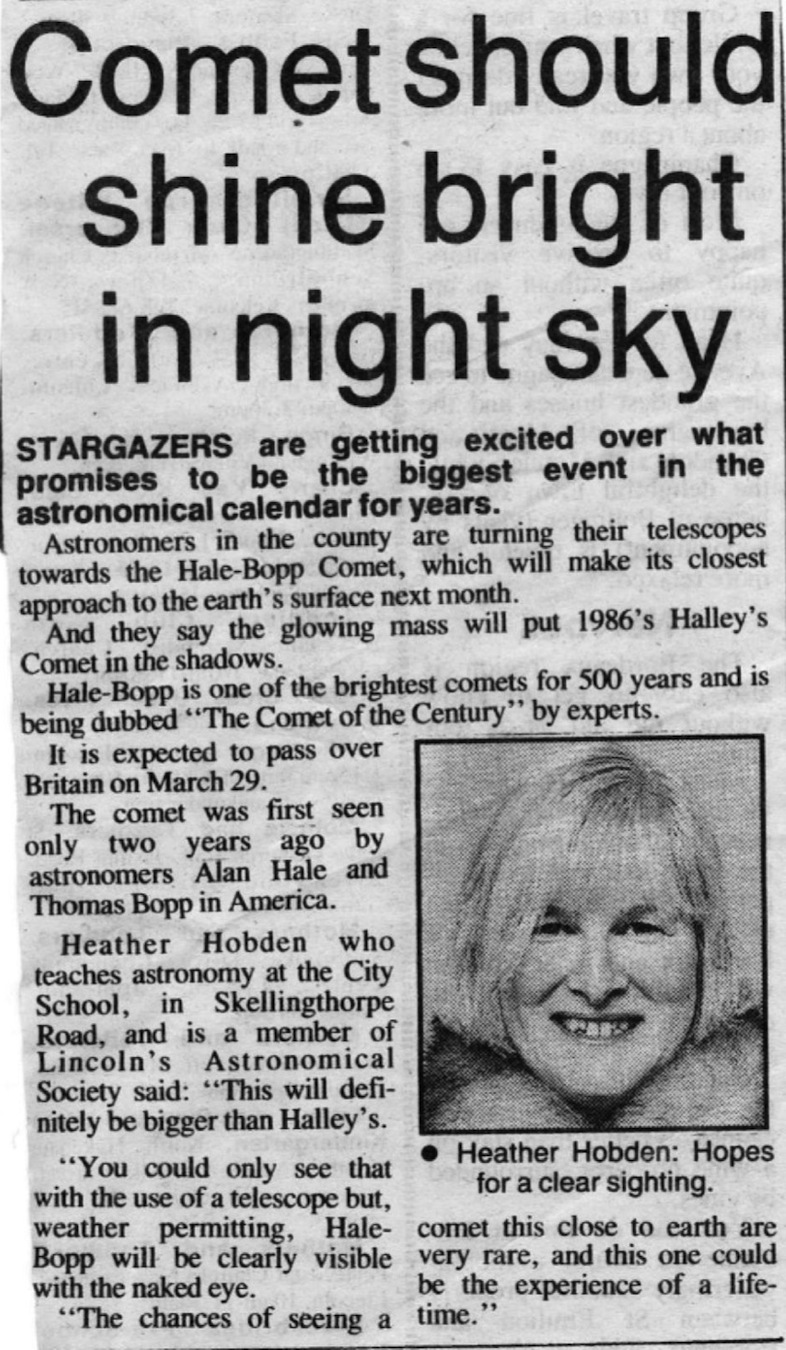 Comets originate in the outer reaches of the solar system. This region of icy planets and smaller icy objects, was assumed to exist long before the planets and and smaller bodies in this area were actually discovered. When their orbit is disturbed they may hurtle in towards the Sun, some of them to break up completely, others to a new orbit. When they are getting near the Sun the icy material boils off and they outgas, emitting clouds of dusty gas containing cyanogen radicals. The solar wind blows this gas away from the Sun and it streams out in a tail. Looking at comet tails, it is possible to see the difference between the dusty tail, and the plasma tail of heated gas.
Comets originate in the outer reaches of the solar system. This region of icy planets and smaller icy objects, was assumed to exist long before the planets and and smaller bodies in this area were actually discovered. When their orbit is disturbed they may hurtle in towards the Sun, some of them to break up completely, others to a new orbit. When they are getting near the Sun the icy material boils off and they outgas, emitting clouds of dusty gas containing cyanogen radicals. The solar wind blows this gas away from the Sun and it streams out in a tail. Looking at comet tails, it is possible to see the difference between the dusty tail, and the plasma tail of heated gas.
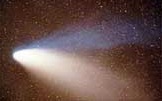 The Hale-Bopp comet more than made up for the poor showing of Halley.
The Hale-Bopp comet more than made up for the poor showing of Halley.
It was a magic sight for 1997 the year of change, deaths of Princess Diana and my dad.
New long distance comets may be quite large -like Hale-Bopp, but as they tend to break up at perihelion, on subsequent orbits they will be smaller and smaller until they are just stones and dust, or a small dark dead body, another small asteroid. There are thousands of tiny icy comets impacting with the Earth's atmosphere every day. It is thought comets must bring water to planets, and also contain organic material even primitive organisms.
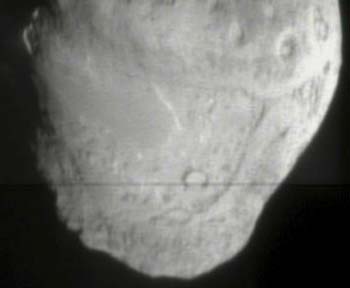
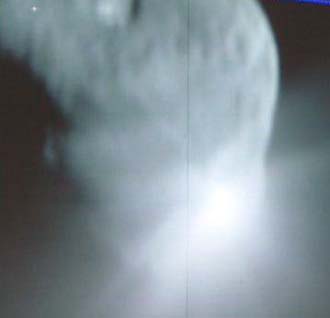 Impact with comet Tempel happened early on July 4th 2005.
Impact with comet Tempel happened early on July 4th 2005.
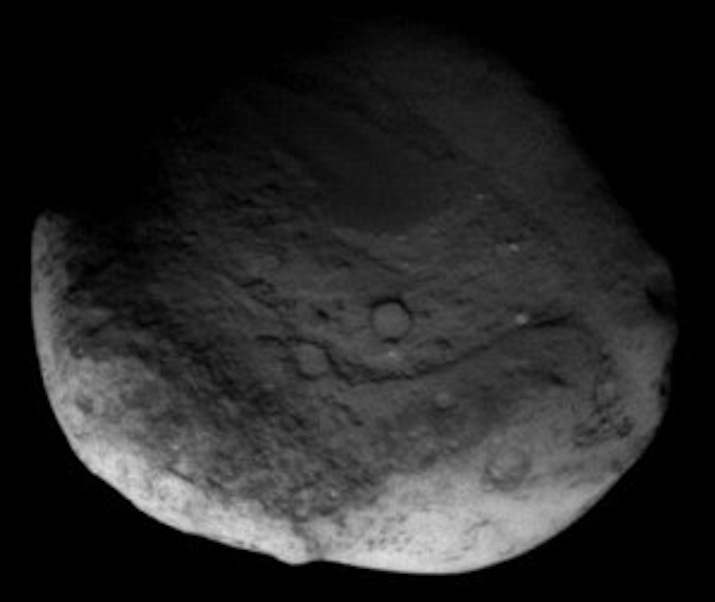 Analysis of the data shows that the comet is made of soft snow and dust. It is very porous and this means the interior is protected from heating up as much as the surface when the comet is near the Sun. The material contains carbon molecules. It is possible - as predicted - that comets brought water and the beginnings of life to Earth. Further results show that the composition of this comet was not entirely as once thought. The other picture shows the bypass of Tempel-1 in February 2011.
Analysis of the data shows that the comet is made of soft snow and dust. It is very porous and this means the interior is protected from heating up as much as the surface when the comet is near the Sun. The material contains carbon molecules. It is possible - as predicted - that comets brought water and the beginnings of life to Earth. Further results show that the composition of this comet was not entirely as once thought. The other picture shows the bypass of Tempel-1 in February 2011.
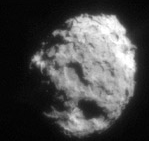
Results show that - although the comet's orbits extends outside the main planets of the solar system - as far as Pluto, some of the comet originated in the early sun.
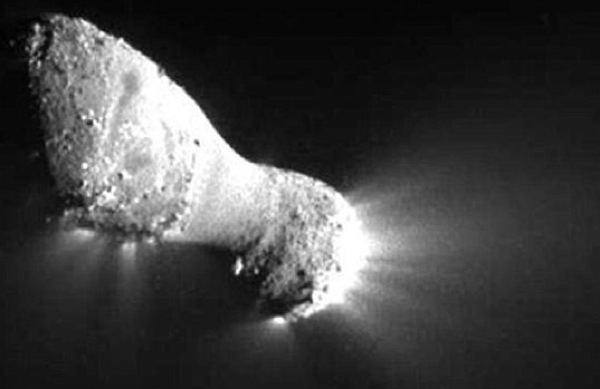 Comet Hartley-2 as seen by the NASA EPOXI Mission Deep Impact spacecraft as it passed by within 435 miles of the comet on 4th November 2010. Comet Hartley was discovered by British astronomer Malcolm Hartley, and can be seen looking like green fuzzy blob, from Earth when it is passing by on its orbit.
Comet Hartley-2 as seen by the NASA EPOXI Mission Deep Impact spacecraft as it passed by within 435 miles of the comet on 4th November 2010. Comet Hartley was discovered by British astronomer Malcolm Hartley, and can be seen looking like green fuzzy blob, from Earth when it is passing by on its orbit.

On the way to Comet 67P/Churyumov-Gerasimenko Rosetta had a fly-by on 5th September 2008 of asteroid (2867) Steins. This enabled the equipment to be tested.
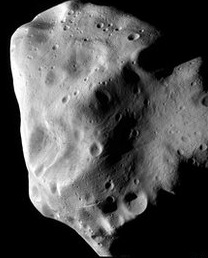 | Picture is of asteroid 21 Lutetia, taken from Rosetta 10th July 2010. |
| Rosetta arrived at Comet 67P/Churyumov-Gerasimenko on 6th August 2014, this picture was taken on approach on 3rd August 2014. |
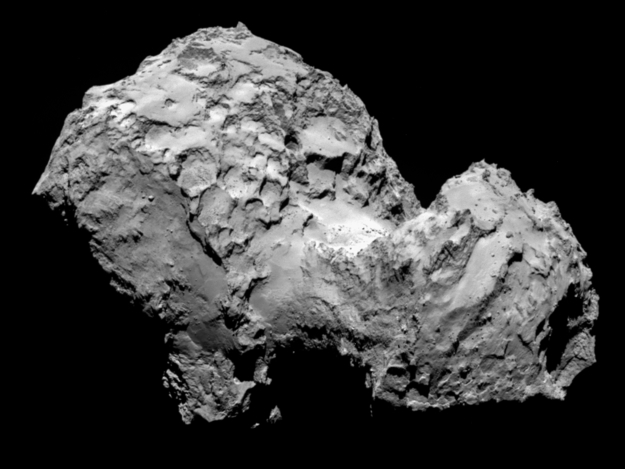 |
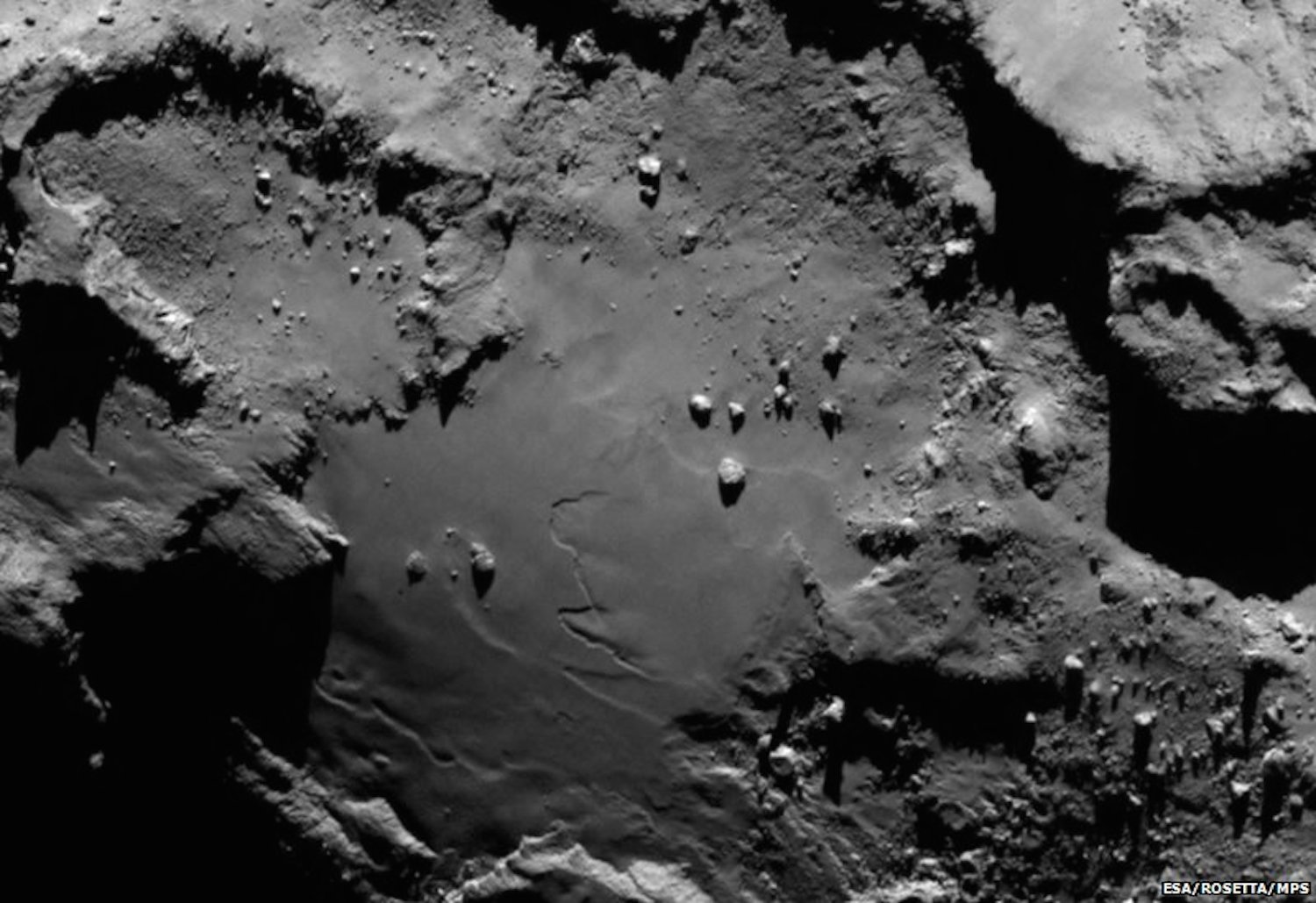 |
| The above image was taken from a distance of 130km and the image resolution was 2.4 metres per pixel. |
| Comet 67P/Churyumov-Gerasimenko from Rosetta, 6th August, 2014. |
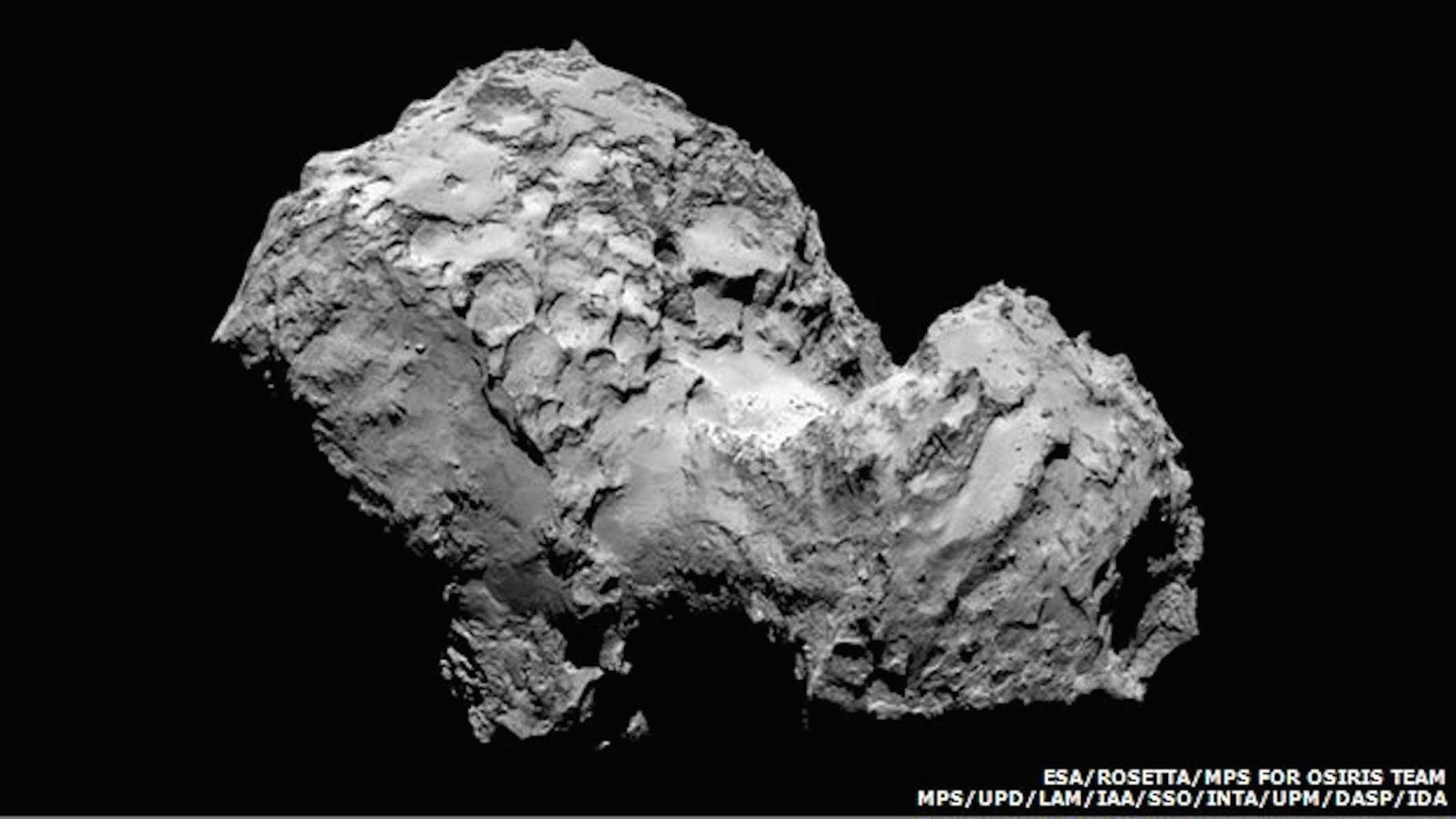 |
| This image was taken from a distance of 130km and the image resolution was 2.4 metres per pixel. |
 |
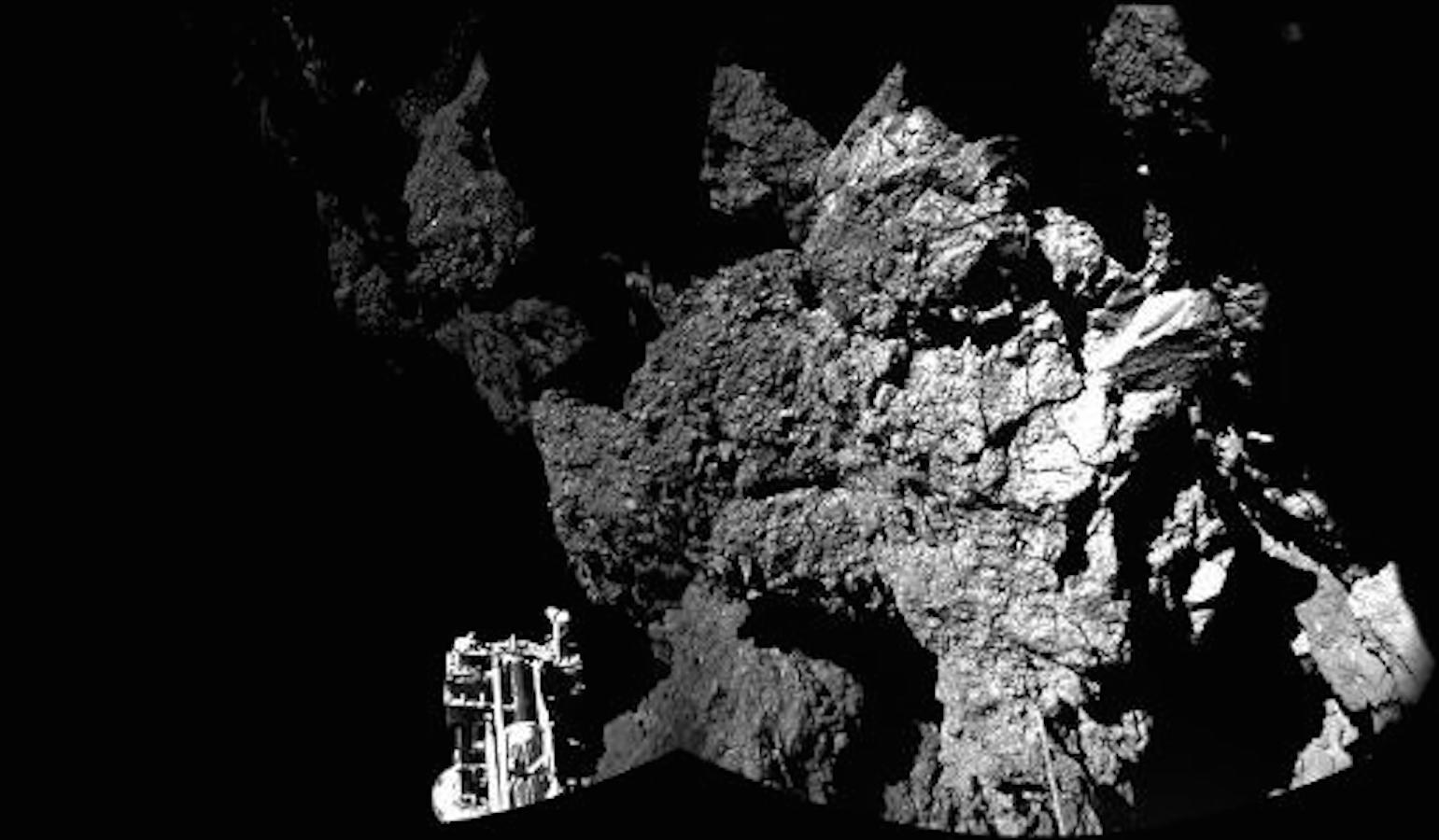 |
| View from Philae probe, (which is about the size of a washing machine), when it landed on comet 12th November 2014. |
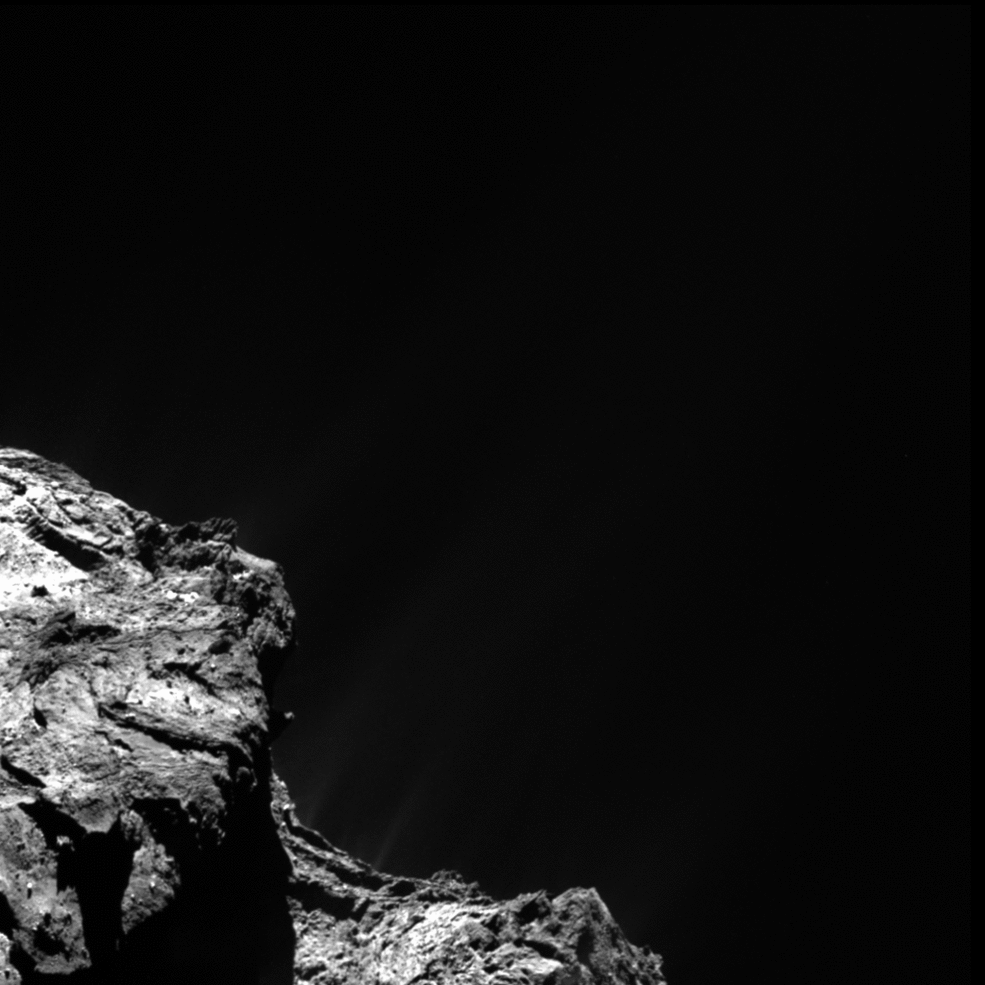 |
| Rosetta will follow the comet as it heads towards the sun at a speed of 18 km (11 miles) a second, reaching somewhere between the orbits of Earth and Mars before heading out again. |
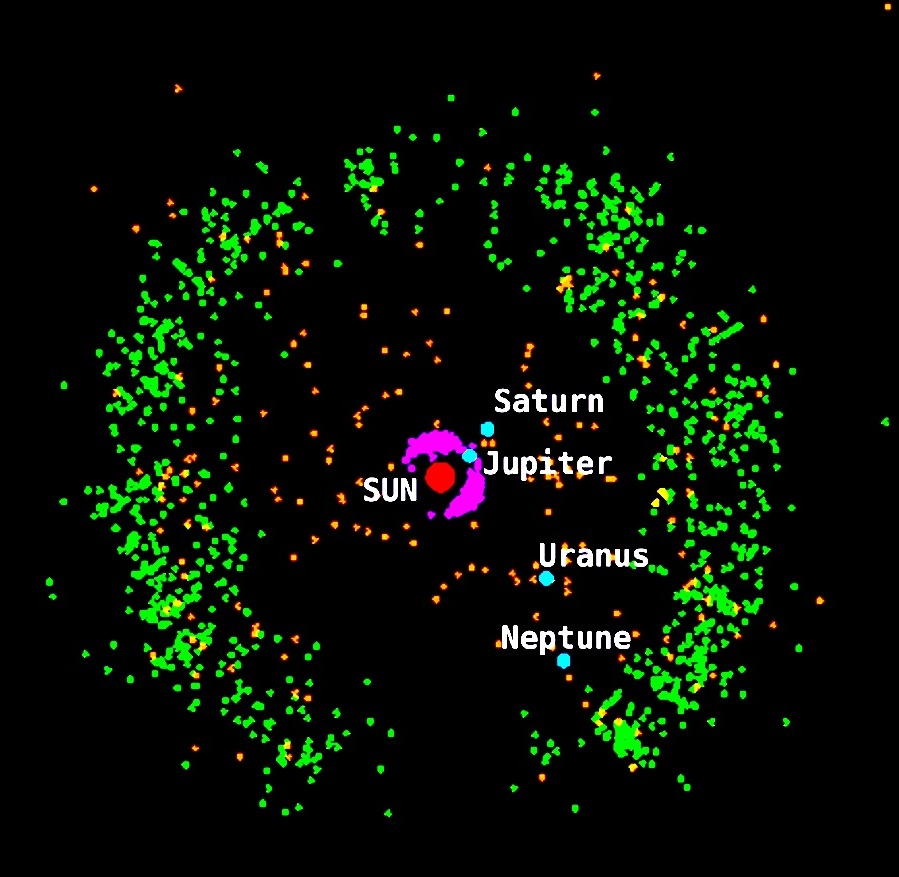
After the discovery of Neptune, it still seemed that the orbits of Uranus and Neptune could be affected by another large planet. (The result of misleading calculations). Percival Lowell (1855-1916) a wealthy amateur astronomer famous for his discovery of the canals on Mars undertook to search for Planet X at his observatory, Flagstaff, Arizona. The search continued after his death and on 18th February 1930, Clyde Tombaugh (1906-1996) identified a new planet from the photographic plates he had developed. He noticed a star had moved position on the plates, so it must be an object in the solar system.

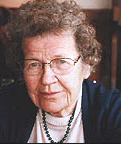 The name Pluto was thought of by an 11-year old girl called Venetia Burney. The pictures show her at the time and as Mrs. Phair in 2006. The name she chose seemed ideal because (although it might have been inspired by the Disney dog) it tied in with the names of Roman gods for the other planets - Pluto was the Roman god of the Underworld, and because PL were Lowell's initials. But although Pluto was accepted as the 9th Planet it turned out to be far too small to be Planet X.
The name Pluto was thought of by an 11-year old girl called Venetia Burney. The pictures show her at the time and as Mrs. Phair in 2006. The name she chose seemed ideal because (although it might have been inspired by the Disney dog) it tied in with the names of Roman gods for the other planets - Pluto was the Roman god of the Underworld, and because PL were Lowell's initials. But although Pluto was accepted as the 9th Planet it turned out to be far too small to be Planet X.
Pluto is similar to but smaller than Triton, which may have the same origins but got swept up into orbiting Neptune backwards.
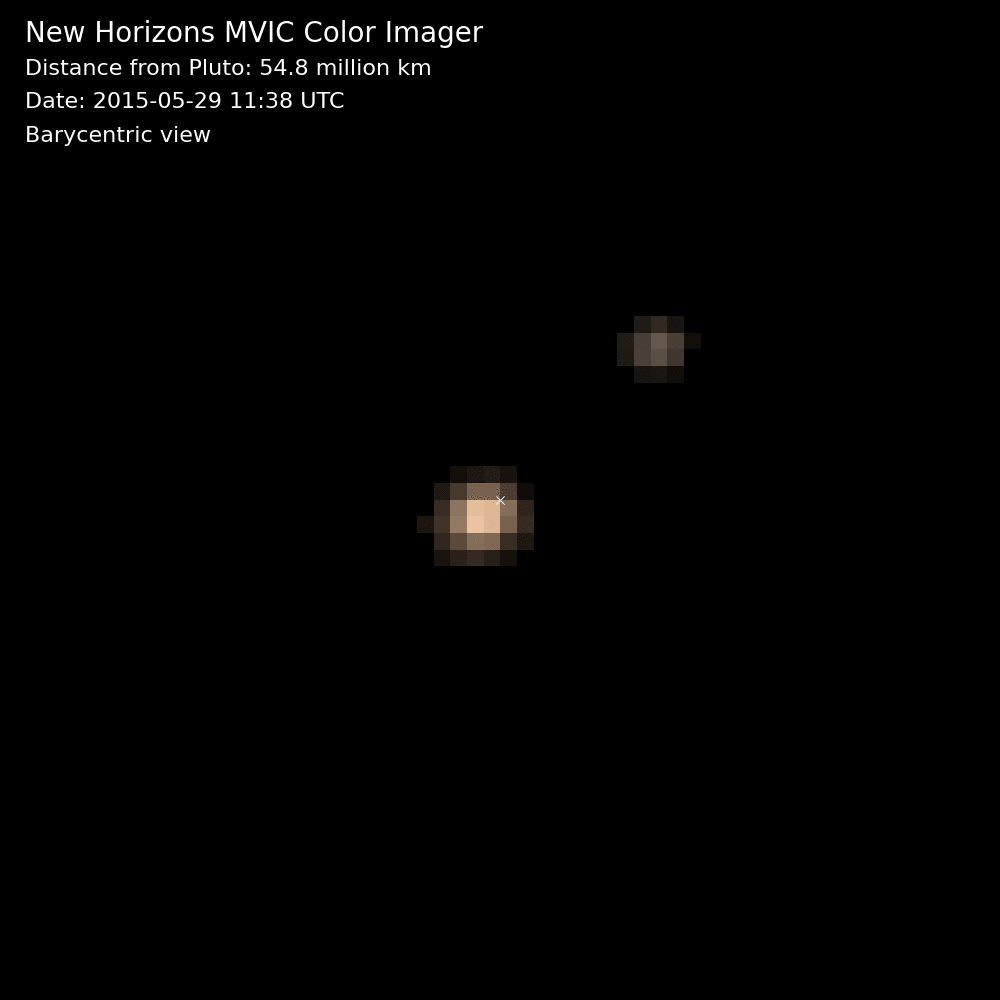 The gif shows Pluto and Charon orbiting each other. This was taken from New Horizons as it approached its destination of Pluto and its companions in May 2015.
The gif shows Pluto and Charon orbiting each other. This was taken from New Horizons as it approached its destination of Pluto and its companions in May 2015.
In June 1978, James Christy discovered Pluto's companion. He called it Charon as he wanted to name it after his wife Charlene, and Charon was a compromise as the name went well with Pluto. Charon was the ferryman who rowed the spirits of the dead across the River Styx to the Underworld.
The Hubble Space Telescope has already shown Pluto and Charon in orbit about each other. Pluto's orbit of the Sun takes 248 Earth years, and is more than 17 degrees inclined to the plane of the ecliptic where the planets and most of the bodies of the solar system lie. It is also very elliptical. From 1979 to 1999 Pluto and its mate Charon were nearer the Sun than Neptune. As it is a small body its orbit is more likely to change chaotically. Pluto's orbit is in 3:2 resonance with that of Neptune.
Pluto's axis is inclined at 122 degrees, nearly as much as Venus (177 degrees) so its 'north' pole is pointing downwards and it appears to rotate backwards (like Venus). Thus Charon as it orbits Pluto may appear above or below it. In the 1950s Pluto's south pole pointed towards the Earth. Pluto and Charon always have the same side facing each other. Charon is the most massive satellite with respect to its planet in the Solar System, more than our moon. It also orbits closer to its planet than any other satellite in the solar system and from Pluto it would look eight times bigger in the sky than our moon does. There must have been a great deal of tidal heating and upheaval when the two bodies first developed their relationship with each other.
Pluto has bright polar caps and a darker, mottled equatorial region. A layer of methane ice covers most of its surface. It has a thin atmosphere of mainly methane, with an atmospheric pressure similar to Triton's. This might be seasonal, appearing when Pluto is nearest the Sun (perihelion) when its distance to the Sun is 4.5 thousand million kilometres. It was at perihelion in 1989. It is 7.4 thousand million kilometres from the Sun at aphelion when it is at its farthest away.
This means that Pluto experiences severe seasonal changes. This might explain Pluto's high albedo, as the methane ice, which normally darkens with age, is reformed each Pluto-year. The surface of Charon is quite different from Pluto's and may be a frozen ocean of water ice. Being smaller than Pluto with lower gravity it would have lost any methane near its surface.
The picture below shows the edge of the frozen plains of Pluto which form a sort of heart shape, visible as lighter and brighter than its surrounds.
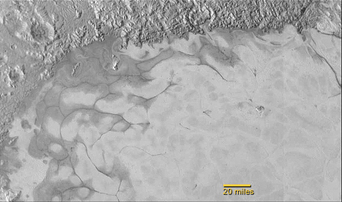
Pluto is 2,320 km in diameter and Charon is about half its size at 1,270 km in diameter. The density of Pluto is 2.1 g/cm3, while that of Charon is only 1.4 g/cm3. Charon is eleven times further away from their common centre of gravity than Pluto so Pluto must have eleven times Charon's mass.So Pluto must be a rocky little planet, while Charon is mostly a snowball. It is thought the twin planet formed when the proto-Charon collided with the proto-Pluto. Pluto lost its layers of ice and Charon kept its. This scenario is supported by the different spectrums of the two and by their colour. Charon is bluer than Pluto.
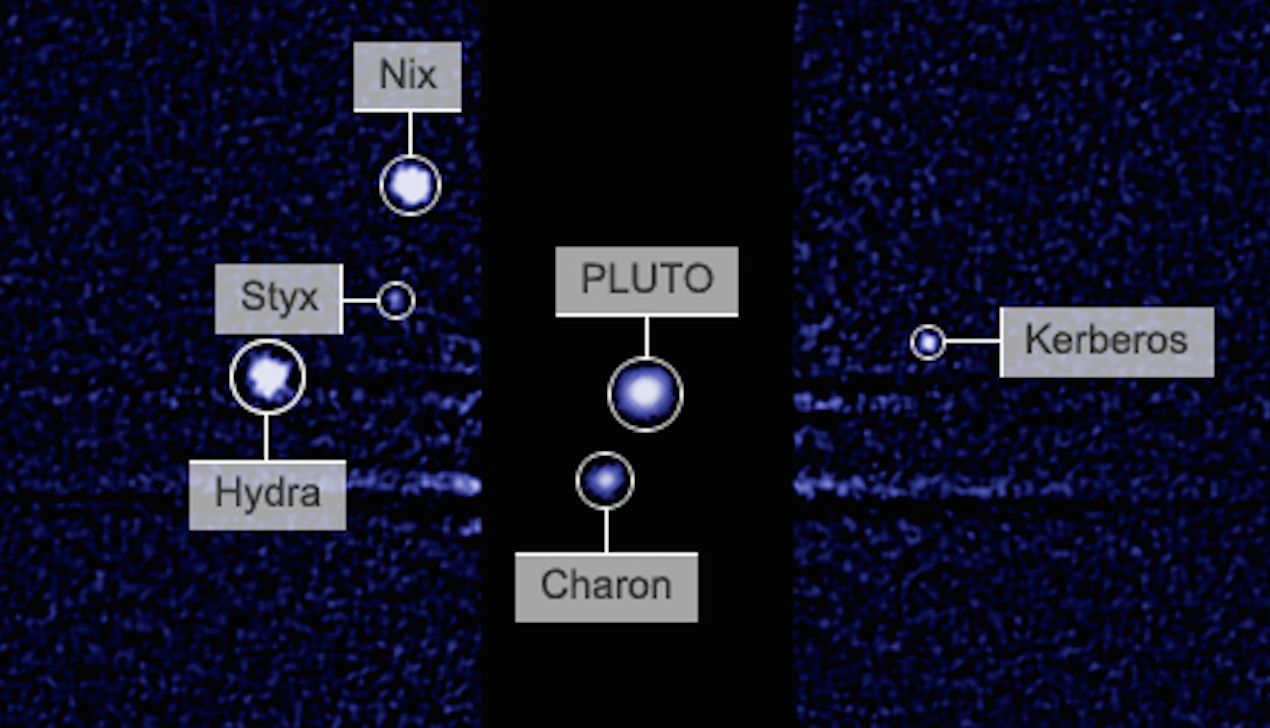
In May 2005 using the Hubble space telescope, two more moons were discovered orbiting Pluto. Called orignally, S/2005 P1 and S/2005 P2, they are approximately 44,000 km from Pluto - more than twice as far from Pluto than Charon. In the picture taken by the Hubble telescope on 15th May 2005 you could see Pluto and Charon and the two other much smaller moons. Their estimated diameters are under 200 km. Further observations were made in February 2006 to confirm the discovery. In June 2006 the moons were officialy named. The more distant of the two new moons (P1) is now known as Hydra, while Nix is the new name for the inner satellite (P2). It should have been Nyx but that was already the name of an asteroid. Nyx was a Greek goddess of darkness and night and also the mother of Charon - the ferryman who took the souls of the dead across the Styx to Hades. Hydra was the 9-headed serpent monster.
Just as Pluto's name was chosen because it also began with PL the initials of Percival Lowell who financed the work that led to its discovery, so H and N stand for the New Horizons mission now on its way to look at Pluto and other Kuiper Belt planets.
More information on Pluto's moons.
August 16th 2006 for the IAU meeting to define the planets, both Pluto and Charon were proposed to be classified as planets under the new definition. It was decided on 24th August 2006, that Pluto be one of a new class of dwarf planets - which orbit the Sun directly, and Charon is a moon as it orbits Pluto. Pluto henceforth known as minor planet 134340 Pluto, according to the new designation by the International Astronomical Union's Minor Planet Centre.
Pluto, Charon and its other moons, are now seen to be part of a number of small bodies orbiting the outer reaches of the solar system. This region is called the Kuiper belt after Gerard Kuiper who postulated this as a source for the shorter period comets. By the end of 1994, eighteen of these small icy worlds had been discovered. Ten years later more than 800 had been discovered. It is certain now, that no more very large planets await discovery, but there must be thousands of small worlds in the outer solar system.
When this trip was planned it was thought Pluto was the 9th planet and an oddity, that got missed on the Voyager tours. Long before the probe reached Pluto, it was known there are lots of planets about the same size and larger, with similar orbits outside Neptune and the plane of the inner solar system. With so many other planet sized bodies - some larger than Pluto and further out - it now seems that icy planets beyond Neptune are the solar-system norm and planets like Earth are the odd ones out.
Before this discovery, a trip to Pluto would have finished off the Voyager tour of the planets - so this trip has been in the planning for many years. Our names are on it.
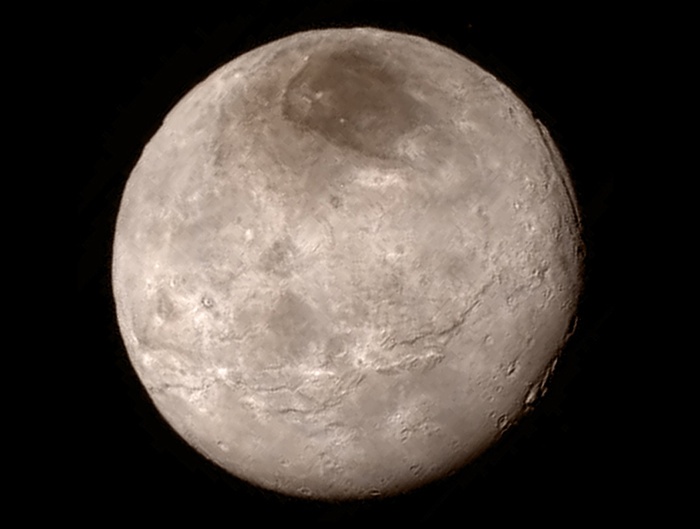 | Closeup on Charon |
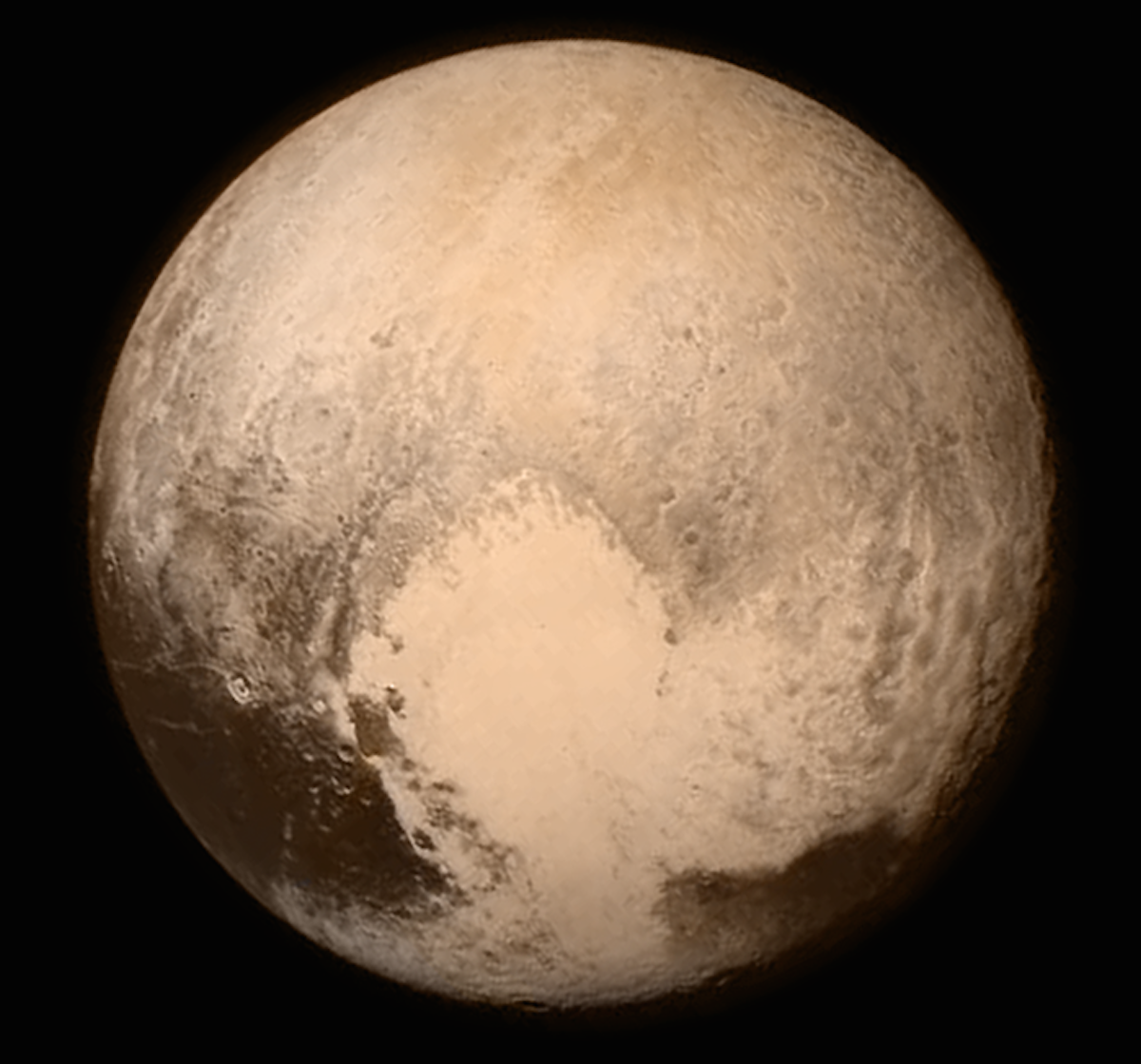 | Closeup on Pluto |
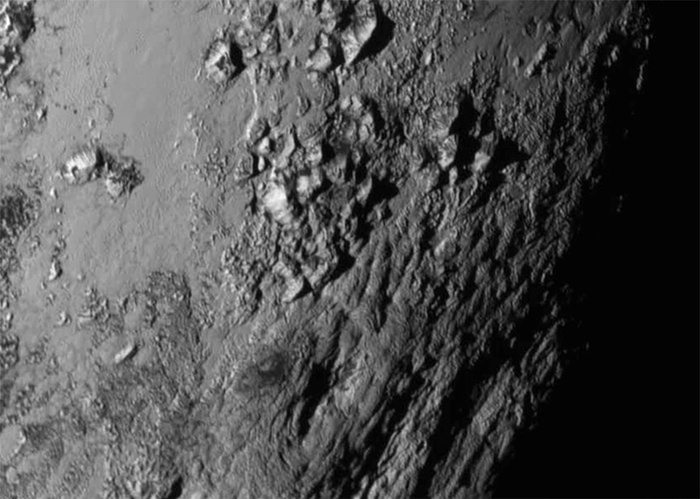 | Icy mountains on Pluto |
 | Frozen plains on Pluto - part of the "heart" shape |
A BBC recording on the latest information on Pluto:
More on:
In September 1992, a similar body to Chiron and Pholus was discovered by Jane Luu and David Jewitt, to have an orbit some 200 kilometres distant from the furthest part of Pluto's orbit. The new planet was called Smiley by its discoverers, after the character in the John Le Carré books. Its official catalogue number given to it by Brian Marsden of the International Astronomical Union is 1992 QB1. 1992 for the year of discovery, then each two weeks in the year is given a letter of the alphabet. (Q was the 2nd half of August). The final letter refers to the order of discovery that month. August 1992 was a busy month for new bodies, A to Z had already been used up, so Marsden was on to A1, then B1. There was a theory that short-period comets including Halley's Comet come from a zone just beyond Pluto, called the Kuiper Belt . This was confirmed by the discovery by Jane Luu of another body beyond Pluto, about 200 km. in diameter. It was called Karla after Smiley's opponent. It is estimated that there may be around ten thousand bodies of a similar size out there. By the end of 1994, about 18 had been discovered, by April 1995, 59, and many more are being discovered by the Hubble Space Telescope. They confirm the existence of the Kuiper belt - a postulated area around the Solar System which would be the source for short period comets.
It has been estimated that 30,000 to 50,000 icy asteroids, or ice dwarfs, with a diameter of more than 100 kms exist between 4.5 and 7.5 thousand million km from the Sun, and about one to ten thousand million of more than one kilometre in diameter.
Jane Luu discovered another new mini planet, 1996 TL66, 500 kilometres diameter, orbit 800 years. 130 A.U. at furthest from the Sun. Jane Luu said this planet is the third largest trans-Neptunian object after Pluto and its satellite Charon. Its large eccentric orbit implies it was scattered by something. It is estimated there could be 6,400 others in the same region.

- about half the size of Pluto was discovered by the Hubble space telescope. It's orbit of 288 years round the Sun is nearly circular. It is named after a creation god of the Native American Tongva tribe - the original inhabitants of Los Angeles. Quaoar came down from heaven; and, after reducing chaos to order, laid out the world on the back of seven giants. He then created the lower animals, and then mankind.
Quaoar may have once been warmer than it is now - although since its orbit is nearly circular and comes no where near that of Neptune - it has never been nearer the Sun and must have always been in this stable orbit, this means it has had volcanic activity.
 is nearly far enough out to be an Oort Cloud object.
is nearly far enough out to be an Oort Cloud object.
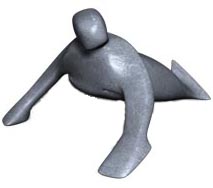 Sedna was named after the Inuit goddess of the sea, who is thought to live at the bottom of the cold arctic ocean. And Sedna the almost-planet nearly as big as Pluto lives in the cold reaches of the outer solar system.
Sedna was named after the Inuit goddess of the sea, who is thought to live at the bottom of the cold arctic ocean. And Sedna the almost-planet nearly as big as Pluto lives in the cold reaches of the outer solar system.
Sedna has been estimated as being near to 18,000 km in diameter - larger than Kuiper belt object Quaoar which is estimated at about 1250 km. And it is 91 times further from the sun than the Earth is.
It has been speculated that Sedna could have been ripped out of another star's solar system on a close encounter - possibly about 4 million years ago when some catastrophic upheaval hit the early solar system.
A close encounter with a companion star would fit the scenario. Stars form in clusters - but our sun seems to be on its own and shooting through another cluster of stars formed out of five of the stars in the northern Plough or Ursa Major, and the southern star Sirius.
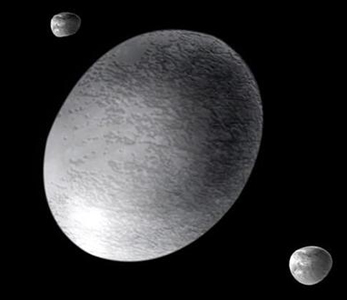 Certainly it is longer along its longest axis. It was found to rotate once every 3.9 hours. This makes it the fastest rotation in the solar system known so far and has given it a shape like a squashed rugger ball - as in picture.
Certainly it is longer along its longest axis. It was found to rotate once every 3.9 hours. This makes it the fastest rotation in the solar system known so far and has given it a shape like a squashed rugger ball - as in picture.
Its density is 2.5 times that of ice and it reflects as brightly as white snow. Two moons found so far, both unusually orbiting on different planes around this strange planet.
2008 - it was finally decided to call this dwarf planet Haumea, after the goddess of childbirth and fertility in Hawaiian mythology. This was the name chosen by Mike Brown who had argued that he had discovered the planet two days earlier than Ortiz.
Haumea joins Pluto, Eris and Makemake as the only known 'plutoids', a term devised by the IAU to describe Pluto-like objects beyond Neptune.
The cigar-shaped Haumea is nearly the same size as Pluto on its long axis. Haumea spins end over end every four hours, making it one of the fastest spinning objects in the solar system.
This spin seems to come from a dramatic crash billions of years ago with another object in the distant Kuiper Belt, a ring of icy bodies beyond Neptune. That collision seems to have created Haumea's two moons, and at least 7 other icy descendents with the same orbit around the Sun, Brown says.
The IAU has credited Brown's team as the discoverer of Haumea's moons. These have been named Hi'iaka and Namaka after two of Haumea's children, which are said to have formed from parts of her body.
Because of the dispute over who found the planet first, the name of the discoverer has been left blank in the IAU listing.
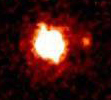
It was claimed by Mike Brown of Caltech, Pasadena, Caliornia, as the "tenth planet" and to be called Xena.
Xena was found to have its own moon - which was unofficially named Gabrielle. The names came from an American series called Xena warrior princess - Gabrielle was her sidekick.
It was the discovery of this planet about the same size as Pluto that had prompted the debate and redefinition of planets.
Xena is now classified under the new definitions as a dwarf planet and Gabrielle as a moon. And from 14 September 2006, Xena and Gabrielle received their official names, both suggested by their discoverer:
Eris, for the dwarf planet formerly known as 2003 UB313 (Xena). In Greek mythology, Eris caused a fight over a golden apple, which led to the Trojan War - she is the goddess of discord - appropiate seeing the discovery of this planet led to a complete re-definition of the solar system.
The moon is called Dysnomia, goddess of lawlessness and Eris's daughter in Greek mythology.
Eris is 3 times further from the Sun than Pluto. In November 2010, it was measured during a stellar occultation, and is the results were announced in October, 2011. Its diameter is estimated at around 2,326 km, which makes it a little bigger than Pluto. Its density of around 2.52 grams per cubit centimetres makes it much denser than Pluto, so it must be mostly rock. Its surface is largely covered with methane ice, and it is seen as grey in colour. It takes 557 years to orbit the Sun.
The faraway world is catalogued as 2004 XR 190 and known temporarily as Buffy. It was discovered as part of the Legacy Survey on the Canada France Hawaii Telescope.
Buffy never gets closer than 52 astronomical units (AU) from the Sun. Neptune is 30 AU from the Sun. Pluto ranges from 30 to 50 AU.
What makes Buffy special is its nearly circular path, which extends out to just 62 AU.
Most other known KBOs are on highly elliptical orbits and off-center orbits, typically coming to within 38 AU of the Sun and then soaring out beyond 50 AU. Theory suggests Neptune has acted on them like a gravitational slingshot to produce these eccentric paths. Buffy's orbit is puzzling.
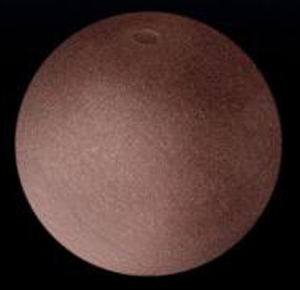 | 2005 FY9 - MakemakeThis is the name of the Easter Island creation god. It was given that name as it was discovered soon after Easter in March 2005 at which time is was temporarily called Easter Bunny. It is a little smaller than Pluto, and is also now a dwarf planet. It is 4 billion miles from the sun which would look like a bright star from its surface. It has little or no atmosphere. |
Spinning hour-glass shaped Kuiper belt object discovered.
Recently, a computer simulation, showed that there could be about ten larger planet sized objects in the outer solar system.
One reason that they are hard to find is the length of their orbits around the Sun and their eccentricity. The orbits of these planets beyond Neptune are off the plane in which the other planets orbit the sun and their orbits swing from far out to near Neptune's orbit or nearer. This applies to Pluto - the first such object to be discovered which is 17 degrees off the plane of the solar system, 2003 EL61 orbits at an angle of 28 degrees, 2003 UB313 at an angle of 44 degrees, and also to the orbits of many comets. It is thought that Pluto, and 2003 EL61 which have orbits which cross that of Neptune, may have been pushed further out by Neptune moving further out.
While there are objections to the estimates of the size of these planets - saying they may just have a high albedo (reflected light from the sun), it does not seem likely this far out, and more probable that these are larger objects of which there are more to be discovered.
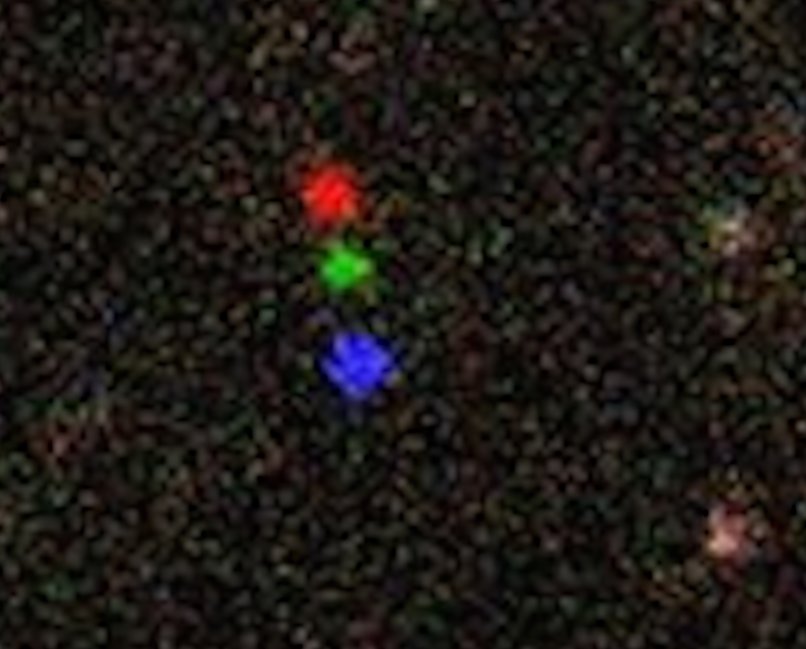
The red colour indicates it could be mostly water-ice, probably with some methane ice and carbon dioxide ice, and rocks. As it is so cold the ice would be harder than rocks on our planet. More information and more on discovery.
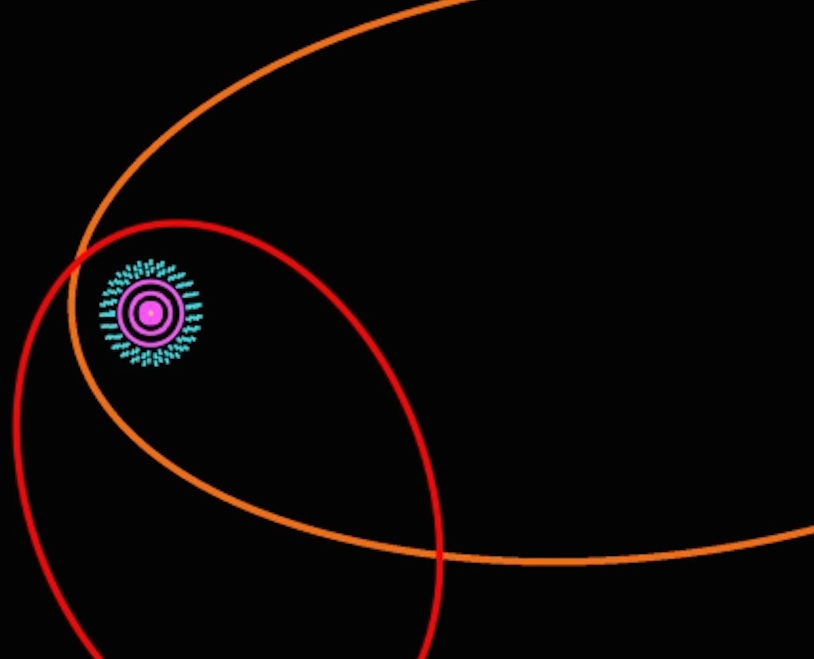 Picture right shows the comparison of the orbit of 2012 VP113 (orange line) with that of Sedna (red line) and the Kuiper Belt (in blue). On this scale the solar system (purple) does not show in detail, the sun and inner planets are the pink dot in the middle.
Picture right shows the comparison of the orbit of 2012 VP113 (orange line) with that of Sedna (red line) and the Kuiper Belt (in blue). On this scale the solar system (purple) does not show in detail, the sun and inner planets are the pink dot in the middle.
In August 2006 this was debated at the IAU. Would there be 12 planets and more on the way - or what. It was decided to have the 8 planets known: that is the 4 rocky planets, Mercury, Venus, Earth, Mars, and the 4 gas giants - Jupiter, Saturn, Uranus, Neptune. And anything large enough for its gravity to pull it into a round shape which orbits the Sun directly and is not a moon going round another planet - is to be a dwarf planet. This includes Pluto, Ceres, Xena, and so on. Those bodies which are too small to be rounded and are not moons are now classified as "small solar-system bodies".
Pluto was checked out again after it was visited and photographed, and is just not big enough to be a planet.

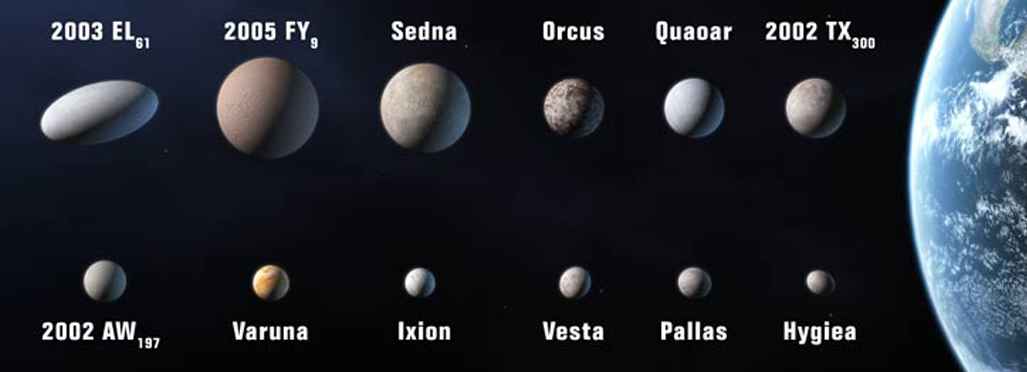
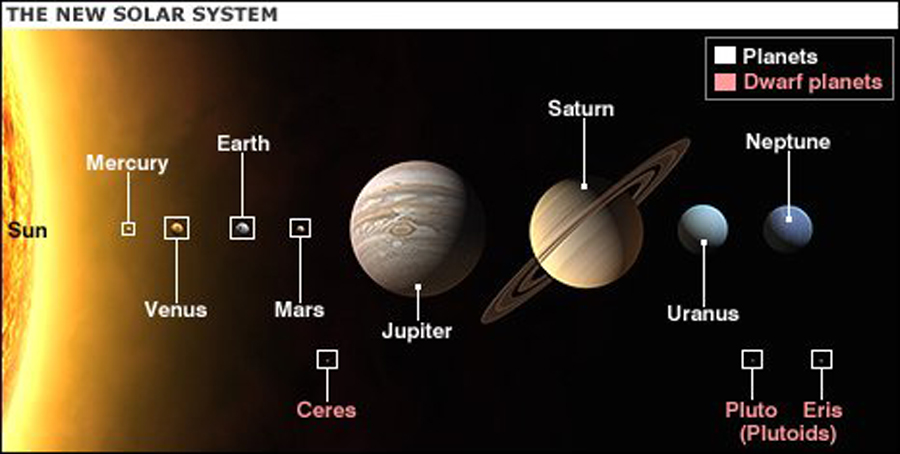
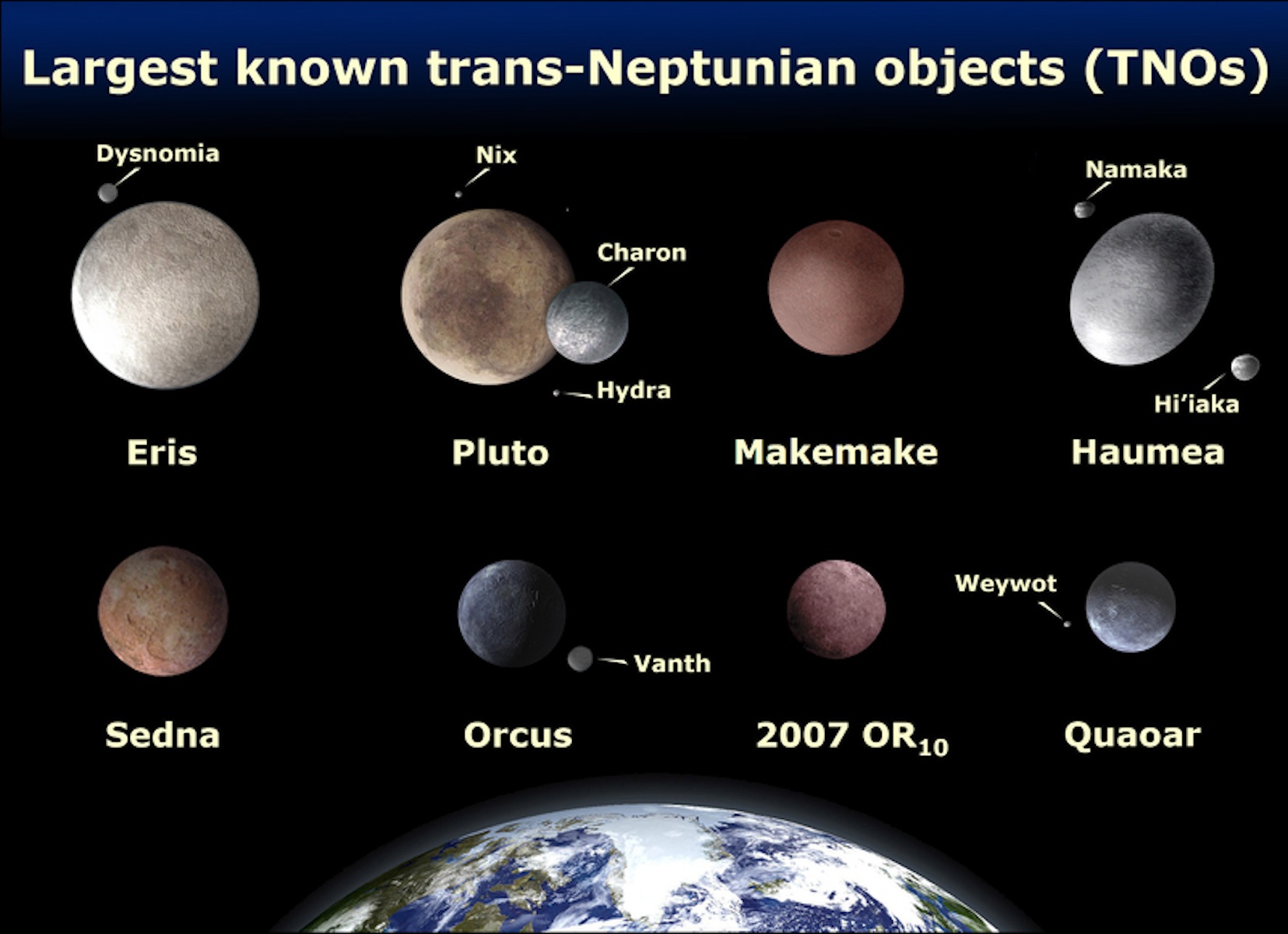
If large enough, their impact could have caused world wide devastation, and mass extinctions through climate change over more than a million years. Such an impact was thought to have been responsible for the sudden extinction of the dinosaurs 65 million years ago, - but although there is a distinct geological boundary layer, and evidence of a large crater dated about this time, this remains controversial. Dinosaurs are now known to be ancestors of birds, not totally extinct, and the climate changes were also occasioned by the Deccan traps - massive volcanic eruptions in India - then still a large island, and the opening out of the Atlantic ocean - all occuring over millions of years, which in itself would cause the changes and evolution of the Earth's population of life.
Meteorites large enough to survive entry into the Earth's atmosphere and land as rocks on Earth, give valuable information, including the origin of the solar system, and of rocks, oceans, and life. Most interesting are those meteorites which are as old as the solar system itself and contain material even older, the debris of a previous star, in the cloud of dust of gas from which our own sun and solar system had formed.
Some meterorites which have landed on Earth are quite large bolders - they have been a source of iron for the Inuits and one is at the centre of Mecca - quite literally a stone from Heaven. Most are small stone sized and are very collectable. It is a chance to possess part of another planet. The best hunting ground is Antarctica where the rocks show against the ancient ice and snow undisturbed by people until the last century.
The Chelyabinsk meteorite's orbit was traced to its origin as an asteroid in the asteroid belt between Mars and Jupiter. It looks like it could have been knocked off course by a collision. Research on the remains have shown how collisions created the Chelyabinsk asteroid and set it on its course to crash on Chelyabinsk.
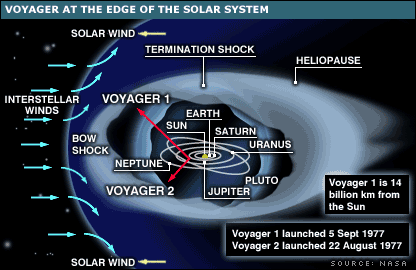
Voyager 1 and Voyager 2 have now left the solar system. Voyager 1 found unexpected magnetic turbulence. Out here the solar wind has slowed - even more than expected, but it still forms a boundary protecting the solar system from the cosmic radiation outside. Voyager 2 crossed the boundary when a billion miles closer to the sun than Voyager 1, showing that the bubble inside the termination shock boundary between the solar system and outer space is a bit squashed.
See video about the long trip to investigate the helio-pause and beyond.
Voyager 1 & 2 now crossing the boundary between our solar system and outside, still sending back interesting new data.
Planets discovered in other solar systems.
Thanks to amazing pictures from Hubble, and other observations - it was realised from the early 1990s that it is quite usual for stars to form with solar systems. As the stars form in spinning lumps of inter-stellar clouds of dust and gas, gravity is compressing the star from the outside, heating it up until, if large enough, it becomes hot enough for nuclear fusion reactions to start in its core - it shines. Meanwhile the centrifugal force from the spinning star is throwing material off its surface - this forms a ring around the star's equator - and lighter material streams off at the poles of the star, leaving the lumpier bits to clump into planets.
As other solar systems have been observed - it has been discovered that our own system is by no means a model - all the solar systems are different and some have Jupiter size planets (almost small stars) very close to the parent sun. Our own solar system may have had a Jupiter like larger body close to the sun at the beginning some 4.6 billion years ago, but it may have merged with the sun - leaving its moons to be the four rocky planets, Mercury, Venus, Earth and Mars. Or it seems that Jupiter was much nearer the sun than it is now and the four rocky planets might even have been its moons as its four largest planet sized moons are today. Certainly our solar system has seen many upheavals, especially in its early years.
Before you get excited about aliens discovering us, bear in mind that it would mean they have a more advanced technology than us. Our history of our life on our own planet shows many times what happens when a few explorers with more advanced technology finds a less advanced people they have never met before. Think of America, Australia etc. And the creatures, plants and bugs, introduced from other countries, running amok. Then think how aliens not even anything like any other creature on this planet might affect us, and regard us. Perhaps we should keep a low profile for now.
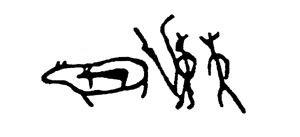 |